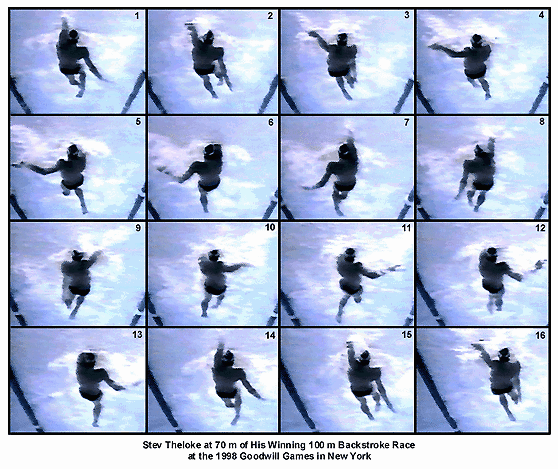HOW CHAMPIONS DO IT
Researched, produced, and prepared by Brent S. Rushall,
Ph.D., R.Psy.

STEV THELOKE AT 70 m OF HIS WINNING 100 m BACKSTROKE RACE AT THE 1998 GOODWILL GAMES IN NEW YORK
Each frame is .1 seconds apart. The time for Stev Theloke's (Germany) swim on this occasion was 54.43, the #1 ranked swim in the world for the year (he defeated Lenny Krayzelberg in this race).
Notable Features
- Frame #1: Left-hand entry is directly behind the head and coincides with the finishing inward scull of the right hand. The over-reach of the left-hand entry (elevation of the left shoulder) causes the hips to sway to the left. The right leg begins to kick to offset the vertical forces created by the entry. That kick initiates a six-beat kicking pattern. The head is well back and deep in the water and contributes to a streamlined flat body position.
- Frame #2: The exaggerated left-hand entry necessitates moving the hand sideways before it is positioned where effective force can be created. The kick is completed. Shoulder rotation to the left begins as the right arm commences a sweeping upward motion at the end of the inward scull.
- Frame #3: The left elbow and wrist flex to facilitate creating force backward. Some medial rotation of the upper arm also occurs to better position the propelling surfaces and to allow adduction to be the principle force producer during the left arm pull. The right arm extracts thumb first.
- Frame #4: The left arm pull continues with a seemingly wide action. That could be because this is a 100-m race and the extra leverage gained from a wider action would be helpful despite it being more fatiguing than a "close" pull. The hand rotates slightly downward. The hips rotate with the shoulders allowing the right kick to prepare to travel partially to the side, a motion that would counter balance the middle of the wide pull. The left leg kicks to counter-balance the right arm exit.
- Frame #5: At mid-propulsion of the left arm the right leg is positioned to counter-balance the vertical forces created as that arm changes to extension. The recent left arm movements were powered by upper arm adduction. The depth of the kick is such that some propulsion can be gained from the kick, a feature that is not possible in crawl stroke.
- Frame #6: Left arm extension occurs and forces the arm to push both back and downward. A big right foot kick counter-balances the downward force component. The pushing hand stays wide adding to the directness of the arm thrust.
- Frame #7: The left arm demonstrates a vigorous inward scull with the hand remaining deep. The right arm prepares to enter. The streamlined longitudinal body position is maintained throughout the left arm's action but the hip sway is a feature for concern. The left leg prepares to kick to counter-balance the entering right arm.
- Frame #8: The right arm enters as the deep left-arm inward scull is completed. The left leg kicks. The exaggerated over-reach of the right arm (elevation of the right shoulder) causes the hips to sway to the right.
- Frame #9: The right arm sweeps out and flexes at the wrist and elbow. The left arm prepares to exit from a deep position below hip level. The left leg kick is halted.
- Frame #10: Hips and shoulders rotate to the right in unison. The right arm pull is powered by upper arm adduction.
- Frame #11: Further hip-shoulder rotation occurs as the right arm sweep adducts but the hand moves toward the surface because of continued left-elbow flexion. The left leg prepares to kick to counter-balance the downward movement of the right arm in extension. It is likely that some propulsion will be derived from this deep kick.
- Frame #12: The right arm begins to extend back and downward. The left leg kicks. The recovering left arm is vertical.
- Frame #13: The right arm pushes back, down, and wide facilitating a direct push. The hand is partially rotated downward. The left leg kick is completed. Body streamline is still maintained.
- Frame #14: The deep inward scull of the right arm commences as the left arm begins to enter. The right leg begins to kick as the left leg sinks. Both those movements facilitate hip-shoulder rotation back to the right.
- Frames #15 and #16: The actions depicted in Frames #1 and #2 are repeated.
Stev Theloke maintains a streamlined (horizontal) position throughout his complete stroke. The hip sway to either side probably should be reduced even if it shortens the reach for entry. The exaggerated reach places the hand behind the head. That necessitates repositioning the hand wider before an effective pull can start. Perhaps it would be better to place the hand wider and eliminate that unproductive movement, which is repeated on both sides.
The latter part of the pull is typical of modern backstrokers. The extension is wide and directly backward. When it is deep it then sweeps inward but remains deep. From there, it is extracted vertically after the other arm begins to initiate a pull.
A six-beat kick is demonstrated. A kick is needed to balance the vertical force components of the entry, the up-down sweep in the middle of the arm's propulsive action, and the extraction. That so much force is generated wide of the body's center-line shows one reason why backstroke is not as efficient as crawl stroke where forces can be generated under the body and near the center-line.

Return to Table of Contents for this section.




